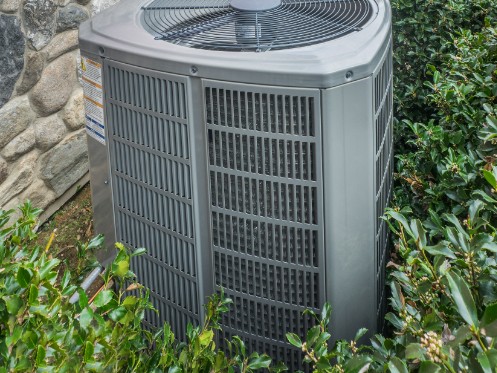A heat pump system is a residential heating and cooling system in which refrigerant transfers radiant heat from one location to another. This is possible because radiant heat naturally flows to an area with a cooler temperature and lower pressure. If the refrigerant is colder than the surrounding air, it absorbs radiant heat and cools the room. If the refrigerant is warmer, it releases radiant energy and warms the area.
Heat Pump Components
The heat pump consists of an indoor air handler and an outdoor unit with a compressor and two valves. Both units have a fan and a coil. The refrigerant flows through the system and will either release radiant energy into a room in the heating mode or absorb it during the cooling mode.
The compressor is responsible for pressurizing the refrigerant gas, increasing its temperature. The compressor efficiently enables the release of heat energy by increasing the temperature and pressure of the refrigerant.
The expansion valve is an essential component within the heat pump system and has the opposite effect of the compressor. The main purpose of this device is to reduce the pressure of the refrigerant. As the refrigerant flows through the expansion valve, pressure reduction occurs. The decrease in pressure causes a drop in the temperature of the refrigerant, leading to the refrigerant’s ability to absorb heat.
The reversing valve plays a crucial role in enhancing the versatility of a heat pump. The valve can invert the complete heat pump cycle, allowing a seamless transition between heating and cooling modes within your residential setting. Upon activation of the reversing valve, the refrigerant flow changes direction, enabling the heat pump to either heat or cool the living spaces.
How Do Heat Pumps Function?
If the flow of the refrigerant travels through the expansion valve and arrives in the air handler at low temperature and low pressure, it absorbs heat from the warmer room. On the other hand, if the flow is in the opposite direction and the refrigerant passes through the compressor before entering the air handler, heat is released into the cooler room. That’s the simple description. A more detailed explanation is presented in the following two sections.
Cooling Process
Throughout the summer season, the heat pump system is in cooling mode with the primary objective of maintaining a comfortable indoor environment within your home. The process entails systematically circulating refrigerant across multiple components to extract heat from indoor air and discharge it outdoors. The operational sequence initiates at the indoor unit, where warm indoor air flows across a coil. The coil contains a cold liquid refrigerant that absorbs heat from the surrounding air. This heat absorption process leads to the evaporation of the refrigerant, transforming it into a gas with a lower temperature. The cooled air is blown back through the air handler while the refrigerant continues its journey to the compressor.
At this point, the gas refrigerant undergoes compression, increasing both its temperature and pressure. The heated and pressurized gas proceeds to the outdoor coil where the refrigerant expels the heat it has absorbed to the surrounding outdoor air, resulting in the condensation of the refrigerant back into a liquid form.
The liquid refrigerant proceeds through the expansion valve, where a reduction in pressure occurs, resulting in a decrease in temperature. Subsequently, the cooled liquid returns to the indoor coil, and the cycle begins again.
Heating Process
During colder weather, the heat pump can reverse its normal operation to deliver heat. The heating process works by facilitating the flow of cold refrigerant over the outdoor coil. The refrigerant absorbs heat from the surrounding air, transforming into a gaseous state through evaporation.
The heated gaseous refrigerant undergoes compression at the compressor, increasing its temperature. The heated gas moves to the indoor unit, expelling its thermal energy into the cooler room. The refrigerant then proceeds through the expansion valve, which lowers its temperature and pressure. The cold refrigerant then flows over the outdoor coil, absorbs heat from the outside air, and repeats the heating cycle.
Benefits of Heat Pumps
Heat pumps are a heating and cooling system that offers comfort and convenience. The paramount aspect of a heat pump is ensuring your comfort, with you having complete control over it. While most individuals typically prefer to reside within a narrow temperature range throughout the year, it is important to note that each person has a subjective interpretation of what constitutes an adequately warm or cool environment. The heat pump’s individual room air handlers allow users to manage and sustain their desired climate conditions at optimal comfort levels.
A heat pump offers the capability to promptly adjust the temperature of a given space, allowing for seamless transitions between heating and cooling modes with a simple button press. The heat pump can stay operational even when the user is away without incurring high costs, allowing for the convenience of returning to a pleasant indoor temperature. Numerous heat pump models offer the advantage of integrating a mobile application, which enables users to conveniently preheat their living spaces before arising on chilly mornings or before returning home from work.
Heat pumps are a space-saving solution. The increasing popularity of heat pumps contributes to the enhanced value of residential properties. The preference for a warm, dry, and comfortable environment, coupled with the inclusion of air conditioning, is consistently prioritized over a dwelling lacking these desirable features. The design and aesthetics of heat pumps help achieve a streamlined and less obstructive appearance, resulting in minimal visibility.
Heat pumps are widely recognized as a highly economical method of utilizing electricity for heating purposes. Compared to alternative heating methods, electric heat pumps demonstrate superior energy efficiency, achieving an efficiency range of 300% to 400%.
Heat pumps are environmentally friendly due to their energy-efficient operation and low carbon emissions. On the other hand, the combustion process of wood burners contributes significantly to the environmental impact due to their carbon emissions. The utilization of heat pumps effectively lessens the consumption of fossil fuels, resulting in negligible carbon emissions and minimal electrical energy consumption. Heat pumps are environmentally friendly due to their utilization of R410A refrigerant, which has the advantage of not causing harm to the ozone layer when released.
Rely on the Pros
Installing a heat pump for residential purposes in Tampa is a significant undertaking that requires careful consideration. Allow the proficient technicians at Home Service Heroes to provide comprehensive guidance throughout the selection process, enabling you to determine the most suitable heating pump for your specific requirements. Our team of technicians consists of licensed professionals who can install, maintain, and repair your HVAC systems. We also provide plumbing, electrical, ductwork, indoor air quality and insulation services. If you live in the Tampa area and have a problem with one of your systems, we can help. Contact Home Service Heroes today for more information or to schedule an appointment!

